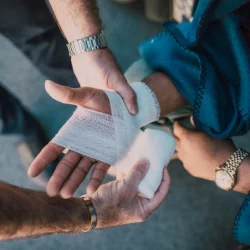How to Document Injuries for a Stronger Personal Injury Case
Being injured in an accident can be overwhelming. Between medical visits, bills, and the emotional toll, the last thing you want to do is paperwork. However, when it comes to securing fair compensation, thorough documentation is key. The more effectively you document your injuries and their impact on your daily life, the stronger your personal injury case will be. Let’s explore how to build a solid foundation for your personal injury claim.
Seek Immediate Medical Attention
Your well-being is your priority after an accident, so the first and most critical step is to seek immediate medical care. Proper treatment is crucial and establishes an official record of your injuries. Delaying medical attention can give insurers or opposing parties a reason to question the severity or cause of your injuries, potentially undermining your claim.
Keep Detailed Medical Records
Accurate medical records are essential to illustrate the scope and progression of your injuries. Collect all relevant documents, including:
- Doctor’s notes detailing diagnoses and treatment recommendations
- Diagnostic test results, like X-rays, MRIs, or CT scans
- Treatment plans from healthcare providers
- Prescription and medication records
These records establish a clear link between the accident and the injuries you sustained, demonstrating both the immediate and long-term effects of the incident. Thorough documentation of your treatment can make a significant difference when negotiating a settlement or presenting your case in court.
Take Photographs of Your Injuries
Photographs are powerful visual evidence that can help substantiate your claims. Take clear, dated photos of visible injuries as soon as possible after the accident, and continue to capture images throughout your recovery. Make sure to take pictures from multiple angles and under different lighting conditions to ensure the photos are as straightforward as possible.
Photographs demonstrate the severity of your initial injuries and document how they change and heal over time. These images can be compelling evidence that shows the physical toll the accident took on your body, reinforcing the other documentation you provide.
Keep a Personal Injury Journal
A personal injury journal is a valuable tool for recording the day-to-day impact of your injuries. By keeping track of pain levels, physical limitations, emotional distress, and other symptoms, you create a narrative that complements your medical records.
In your journal, consider making regular entries that include:
- Changes in pain or discomfort levels
- New symptoms or complications
- Emotional or mental distress related to the injury
- Limitations on activities, such as work, family time, or hobbies
An injury journal can be beneficial when seeking compensation for non-economic damages, like pain and suffering. It provides insight into how the injury has affected your quality of life, making your case more compelling.
Gather Witness Statements and Contact Information
Witness statements can add credibility to your case by offering an objective perspective. Collect contact information and written statements from individuals who witnessed the accident or saw how your injuries have affected your life. These testimonies can be instrumental in backing up your version of events and emphasizing the severity of your injuries.
Witness accounts are beneficial if they provide detailed descriptions of the accident or the impact of your injuries. The more specific and vivid these statements are, the stronger they can make your case.
Retain Copies of Expenses and Treatment Receipts
Financial documentation is critical for supporting claims related to economic damages. Save receipts for all injury-related expenses, including:
- Medical bills from emergency room visits, surgeries, and follow-up care
- Prescription costs and other out-of-pocket medication expenses
- Physical therapy and rehabilitation costs
- Transportation expenses for trips to medical appointments
Organize these receipts chronologically for easy reference. They provide a tangible record of your financial losses due to the injury, helping demonstrate the ongoing impact on your life and aiding in calculating the compensation you deserve.
Consult a Personal Injury Attorney
Documenting your injuries can be challenging, but you don’t have to do it alone. Working with a personal injury attorney can streamline the documentation process and help ensure you’re fully prepared. Your attorney can help you identify the most relevant evidence, avoid common documentation mistakes, and maximize your potential compensation.
An experienced attorney can help you recover damages such as medical expenses, lost wages, pain and suffering, and future care needs related to your injury. Their guidance can be invaluable, especially if you face resistance from insurance companies or opposing parties.
Final Thoughts on Building a Strong Case
Carefully documenting your injuries can make all the difference in the outcome of your case. By working with an experienced personal injury attorney, you can ensure all relevant documentation is presented effectively and increase the likelihood of a successful settlement or judgment.
More to Read:
Previous Posts:




